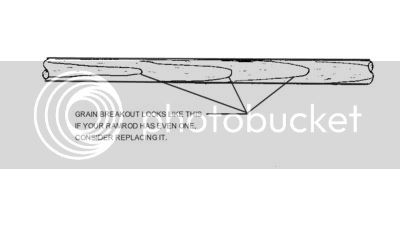Birddog6's method sure sounds faster than mine but I know I'd frinkle it up if I tried using a belt sander.
To get a nice clean shoulder for the metal tip to but up against I use the following method.
After measuring the depth of the hole in the tip, I measure just slightly less than it and make a small pencil mark on the rod.
Laying the rod on a smooth table, I then locate a large Exacto knife blade, held perpendicular to the axis of the rod on the mark.
Rolling the rod along, the knife scores a perfect cut around the rod.
I do this several times until the cut is about 1/32 of an inch deep.
Then using a sharp chisel held at about a 45 degree angle from the rod's centerline, I cut into the wood to remove the excess wood on the tip side of the circular cut. This leaves a nice square corner for the metal tip to butt up against.
Once this notch is made, I use a regular metal cutting flat mill file to reduce the diameter down so that it is a close slip fit to the metal tip.
Because the file is a metal cutting file it cuts real slowly which allows me to sneak up on the right size without removing too much wood.
I use the table to roll the rod on while filing so it removes a fairly uniform amount of wood. This keeps the tip pilot fairly concentric with the rod.
This file by the way has had the teeth on the side of it removed (killed) so it will not cut into the nice shoulder left by the knife even if it touches it.
The rest of it like the epoxying etc is done very much like every one else.

Have Fun!
Zonie







